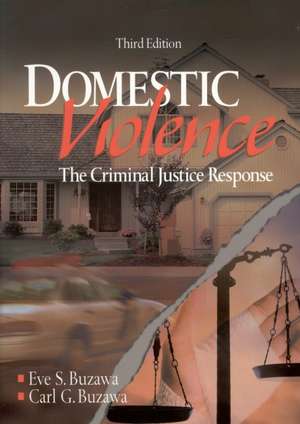Domestic Violence: The Criminal Justice Response
Autor Carl G. Buzawa, Eve S. Buzawa, Eva Schlesinger Buzawaen Limba Engleză Paperback – 30 sep 2002
This is the fully revised and updated Third Edition of one of the top books on domestic violence. The authors have incorporated a wealth of new empirical research on how the criminal justice system's responses to domestic violence have changed in the seven years since the last edition was written.
This book is unique in that it places an emphasis on the victim's perspective: the needs, preferences and satisfaction for intervention, as well as the impact of interventions.
The book examines the victim diversity and how this effects their needs, preferences, and attitudes, as well as their service needs and interventions. It also highlights the diversity among batterers and how this impacts the efficacy of various intervention strategies. It provides an analysis of where innovative programmes have had mixed or inconclusive results, as well as where major strides in research and treatment have been made.
This New Edition is multidisciplinary and will be of interest to academics and students in social work, domestic violence and health administration and policy.
Preț: 334.74 lei
Nou
Puncte Express: 502
Preț estimativ în valută:
64.06€ • 66.50$ • 53.42£
64.06€ • 66.50$ • 53.42£
Carte tipărită la comandă
Livrare economică 21 martie-01 aprilie
Preluare comenzi: 021 569.72.76
Specificații
ISBN-13: 9780761924487
ISBN-10: 0761924485
Pagini: 336
Dimensiuni: 178 x 248 x 20 mm
Greutate: 0.59 kg
Ediția:Third.
Editura: SAGE Publications
Locul publicării:Thousand Oaks, United States
ISBN-10: 0761924485
Pagini: 336
Dimensiuni: 178 x 248 x 20 mm
Greutate: 0.59 kg
Ediția:Third.
Editura: SAGE Publications
Locul publicării:Thousand Oaks, United States
Cuprins
Chapter 1 - Introduction: The Role and Context of the CJ System
The Primacy of the CJ System
A. Have Multiple Goals of the CJ System led to a loss of clarity?
B. Why Changes Occurred?
PART I: CONTEXT OF THE PROBLEM
Chapter 2 - Defining and Measuring Domestic Violence and its Impact
A. What is Domestic Violence
B. How Definitions Impact upon Measurement
C. How Widespread is Domestic Violence: The Problem of Conflicing Studies
D. What is the Incidence of Domestic Violence
E. The Impact of Domestic Violence
F. Is Stalking the Prototypical Offence on Dating Relationships?
Chapter 3 - Risk Markers for Victims, Offenders, and Families
A. Specialized Profile
B. Risk Factors for Victims and the Phenomenon of Revictimization
C. Risk Markers for Families and Sociological Based Theories of the Incidence of Domestic Violence
Chapter 4 - Societal and Historical Factors in Domestic Violence
A. Does Society Create an Atmosphere Conducive to Domestic Violence?
B. Religion and Historical Perspectives
C. The Context of Early American strategies and interventions
D. Does History still Matter
PART II: THE EVOLVING POLICE RESPONSE
Chapter 5 - The Traditional Police Response and Early Innovations
A. The Traditional Approach: Minimal Intervention
B. Crisis Management
C. Does Police Intervention Help?
Chapter 6 - The Push for Greater Criminal Justice Intervention
A. Political Pressure on the Criminal Justice System
B. The Role of Research in Forcing Change
C. Legal Liability as an Agent for Change
Chapter 7 - The Development of State and Federal Legislation
A. Domestic Violence Related Laws
B. Specific Anti-Stalking Legislation
C. The Federal Legislative Response
Chapter 8 - The Increased Policy Preference for Arrest
A. The Increasing Policy Preference for Arrest
B. The Limits and Costs of Mandatory Arrest
C. The Cost of Unintended Effects of Arrest
D. The Diversity for the Victim Needs and Divergent Impacts of Madatory Arrest
Chapter 9 - Factors Effecting Organizational Variations
A. Situational and Incident Characteristics
B. Police Evaluation of Victim Traits and Conduct
C. Assailant Behavior and Demeanor
D. Organizational Variations Among Police Departments
E. The Importance of Training
F. Domestic Violence in the Context of Community Policing
Chapter 10 - Variations in Police Response to Domestic and Non-Domestic Violence
A. Impact of Differential Police Interveintions
PART III: WHAT HAPPENS AFTER ARREST? THE ROLE OF THE PROSECUTORS AND THE COURTS
Chapter 11 - Classic Patterns of Non-Intervention by the Prosecutors and Courts
A. The Victim's Experience
B. Unique Factors Limiting Effectiveness of Prosecutors in Combating Domestic Violence
C. The Impact of Pro-Arrest Practices: The Dilemma of Growing Caseloads
D. Case Disposition by the Judiciary
Chapter 12 - The Increased Role of Restraining and Protective Orders
A. The Increasing Use of Protective Orders
B. The Complex Problem of Re-Abuse
C. Are there Other Avenues for Civil Court Relief of Violence?
Chapter 13 - The Changing Prosecutorial Response
A. Victim Support And Victim Advocacy Programs Within Prosecutor Offices
B. No - Drop Policies
C. Victims Charged with Child Endagerment
D. Are there Alternate Models of Empowering Victims that Prosecutors can Follow?
E. Can Comprehensive Prosecutorial Programs have an Impact on Domestic Violence: A Case Study
Chapter 14 - Judicial Innovations: the First Steps Diversions from the Criminal Justice Systems
A. The Lack of a Coordinated Response by the Judiciary
B. Court Sponsored Diversions
C. Court Sponsored Mediation Programs
D. Batterer Intervention Programs
Chapter 15 - Innovations in Judicial Processing and Disposition
A. The Role of Specialized Domestic Courts
B. Integrated Domestic Violence Case Management
C. Integrated Coordinating Councils
D. Do Integrated Programs Work?
The Primacy of the CJ System
A. Have Multiple Goals of the CJ System led to a loss of clarity?
B. Why Changes Occurred?
PART I: CONTEXT OF THE PROBLEM
Chapter 2 - Defining and Measuring Domestic Violence and its Impact
A. What is Domestic Violence
B. How Definitions Impact upon Measurement
C. How Widespread is Domestic Violence: The Problem of Conflicing Studies
D. What is the Incidence of Domestic Violence
E. The Impact of Domestic Violence
F. Is Stalking the Prototypical Offence on Dating Relationships?
Chapter 3 - Risk Markers for Victims, Offenders, and Families
A. Specialized Profile
B. Risk Factors for Victims and the Phenomenon of Revictimization
C. Risk Markers for Families and Sociological Based Theories of the Incidence of Domestic Violence
Chapter 4 - Societal and Historical Factors in Domestic Violence
A. Does Society Create an Atmosphere Conducive to Domestic Violence?
B. Religion and Historical Perspectives
C. The Context of Early American strategies and interventions
D. Does History still Matter
PART II: THE EVOLVING POLICE RESPONSE
Chapter 5 - The Traditional Police Response and Early Innovations
A. The Traditional Approach: Minimal Intervention
B. Crisis Management
C. Does Police Intervention Help?
Chapter 6 - The Push for Greater Criminal Justice Intervention
A. Political Pressure on the Criminal Justice System
B. The Role of Research in Forcing Change
C. Legal Liability as an Agent for Change
Chapter 7 - The Development of State and Federal Legislation
A. Domestic Violence Related Laws
B. Specific Anti-Stalking Legislation
C. The Federal Legislative Response
Chapter 8 - The Increased Policy Preference for Arrest
A. The Increasing Policy Preference for Arrest
B. The Limits and Costs of Mandatory Arrest
C. The Cost of Unintended Effects of Arrest
D. The Diversity for the Victim Needs and Divergent Impacts of Madatory Arrest
Chapter 9 - Factors Effecting Organizational Variations
A. Situational and Incident Characteristics
B. Police Evaluation of Victim Traits and Conduct
C. Assailant Behavior and Demeanor
D. Organizational Variations Among Police Departments
E. The Importance of Training
F. Domestic Violence in the Context of Community Policing
Chapter 10 - Variations in Police Response to Domestic and Non-Domestic Violence
A. Impact of Differential Police Interveintions
PART III: WHAT HAPPENS AFTER ARREST? THE ROLE OF THE PROSECUTORS AND THE COURTS
Chapter 11 - Classic Patterns of Non-Intervention by the Prosecutors and Courts
A. The Victim's Experience
B. Unique Factors Limiting Effectiveness of Prosecutors in Combating Domestic Violence
C. The Impact of Pro-Arrest Practices: The Dilemma of Growing Caseloads
D. Case Disposition by the Judiciary
Chapter 12 - The Increased Role of Restraining and Protective Orders
A. The Increasing Use of Protective Orders
B. The Complex Problem of Re-Abuse
C. Are there Other Avenues for Civil Court Relief of Violence?
Chapter 13 - The Changing Prosecutorial Response
A. Victim Support And Victim Advocacy Programs Within Prosecutor Offices
B. No - Drop Policies
C. Victims Charged with Child Endagerment
D. Are there Alternate Models of Empowering Victims that Prosecutors can Follow?
E. Can Comprehensive Prosecutorial Programs have an Impact on Domestic Violence: A Case Study
Chapter 14 - Judicial Innovations: the First Steps Diversions from the Criminal Justice Systems
A. The Lack of a Coordinated Response by the Judiciary
B. Court Sponsored Diversions
C. Court Sponsored Mediation Programs
D. Batterer Intervention Programs
Chapter 15 - Innovations in Judicial Processing and Disposition
A. The Role of Specialized Domestic Courts
B. Integrated Domestic Violence Case Management
C. Integrated Coordinating Councils
D. Do Integrated Programs Work?
Descriere
This is the fully revised and updated Third Edition of one of the top books on domestic violence. The authors have incorporated a wealth of new empirical research on how the criminal justice system's responses to domestic violence have changed in the seven years since the last edition was written.













